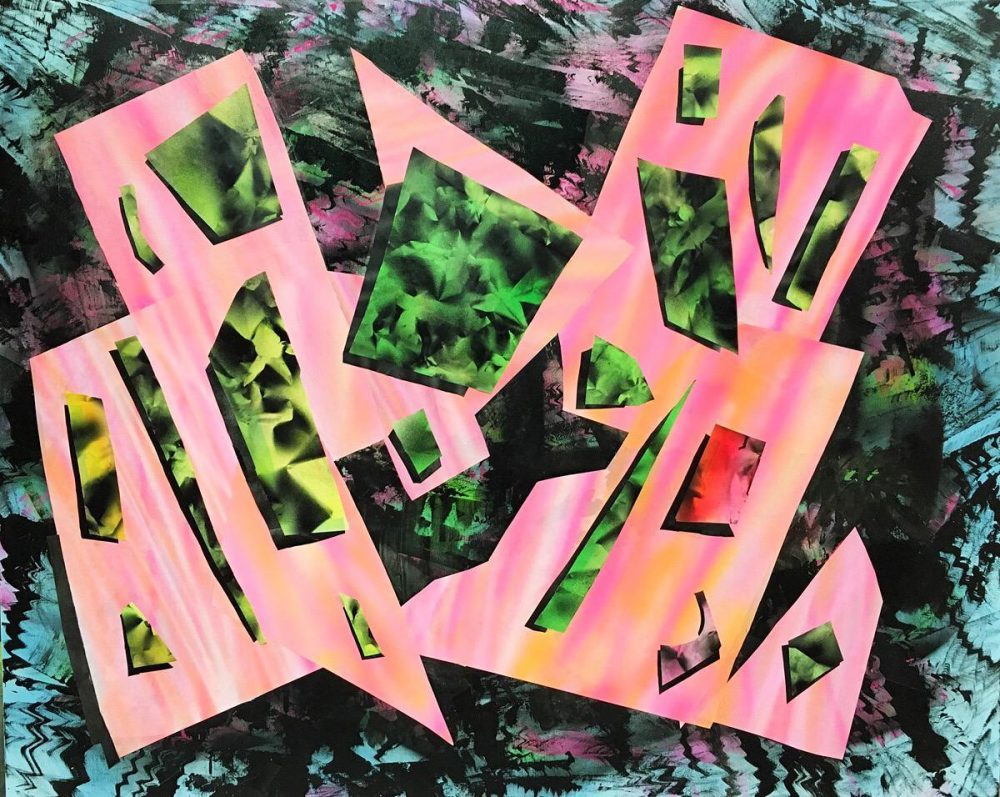Digital Arrangements: Jessica Bizer at Good Children Gallery
Marjorie Rawle contemplates how Jessica Bizer translates the digital world into painting in her recent show at Good Children Gallery.

Jessica Bizer, Sun Tunnel, 2016. Acrylic and airbrush on canvas. Courtesy the artist.
Today’s technology provides more than enough ways to create hyperrealistic versions of reality. Artist Jessica Bizer uproots the typical tools and tricks of the digital world—cast shadows, gradients, occlusion, and perspective, to name a few of the most common—from their origins on our computer screens and transforms them under the weight of her paintbrush and scissors. Recently on view at Good Children Gallery, “So That’s What Happened” almost imperceptibly blended the digitized and the painted, the real and the imagined, reminding us that, though the devices of digital design have become practically invisible with overuse in our contemporary landscape, they can always be rediscovered and repurposed.
Feeling the overpowering pull of huge swaths and shards of neon and black that surge from Bizer’s life-size, abstract canvases, it was difficult to resist and stop for the three small prints that preceded her massive paintings in the flow of the exhibition. Yet these three works that Bizer framed from her “Photoshop sketchbook” acted as a prologue, a crucial indication that the artist’s work is inspired by and firmly rooted in the digital. In these “sketches,” which are resplendent in rainbow color and brimming with butterflies, bubbles, panthers, and unicorns, Bizer employs digital devices that would ordinarily create a strong sense of three-dimensional space if it were not for the way she smears, stretches, cuts, and pastes them all over the picture plane, effectively flattening and warping her fantastically manufactured digital environments.
While Bizer doesn’t replicate these “sketches” on her canvases, as one might traditionally expect, the connections between the two are evident in their compositions. Photoshop Sketchbook (Unicorn), 2016, and its neighboring painting Bring Us Some Artifacts, 2017, shared the same lively, all-over compositions. And the floating, jagged shape of the crystal cluster in Photoshop Sketchbook (Crystal), 2016, was echoed in each of the large canvases, perhaps most obviously in Sun Tunnel, 2016. Beyond compositional inspiration, Bizer also works to retain the hard-edged quality of her digital works in her paintings by assembling materials like acrylic paint, airbrush, and an adhesive fabric called Photo Tex on canvas, often, but not necessarily, in that order.

Jessica Bizer, Photoshop Sketchbook (Crystal), 2016. Digital print. Courtesy the artist.
While these two bodies of work certainly inform one another, Bizer’s abstract paintings did diverge from the digital “sketches” on view. Not only does she leave behind all hints of the representational and shift her color palette to an acidic neon, there is also an enveloping energy and depth to most of her canvases that was noticeably lacking in the three Photoshop sketches. Whether owed to gargantuan size, odd shapes, blinding color, or a combination of all three, the quirky geometric shrapnel of Champions, Officially, 2017, and Vacation, 2017, seemed trapped between energy states, ever-so-slightly vibrating in hopes of soon being released back into the swirling abyss of the background.
These crisp cut-outs and their dynamic arrangements unquestionably contribute to the overall vivacity of the canvases, but their irregular shapes seem much less arbitrary when we consider Bizer’s constant play between the painted and the digital. As if plucked right from a nearby computer screen, the flat black scraps of Typical Daydream, 2016, look as if they could be digitally manufactured shadows on the loose, subsequently captured and corralled within Bizer’s neon pink cage. Similar black fragments appeared frequently throughout the show, sometimes seemingly functional as in Sun Tunnel’s well-behaved drop shadows, but more often going rogue, floating off to join Bizer’s other liberated, multicolored strips of Photo Tex.
Formed by a complex layering process that often strains the eye and confounds the brain, Bizer’s painted spaces in “So That’s What Happened” were almost never straightforward or realistic, but instead formed a convoluted network of eccentric shapes and rowdy brushstrokes that repeatedly threatened to envelop us. Should we be opposed to this, seeing as we are already tucked tightly into a highly fabricated digital landscape? If you think it’s “time to freak out” (the phrase proclaimed by a small, gold-framed work floating high above the exhibition) as Bizer does, fear not, because she also showed us just how simple it can be to deconstruct the spaces around us to create one that is wholly new, inviting, and effervescent.
Editor's Note
Jessica Bizer’s “So That’s What Happened” was on view February 10 - March 5, 2017, at Good Children Gallery (4037 St. Claude Avenue) in New Orleans.



